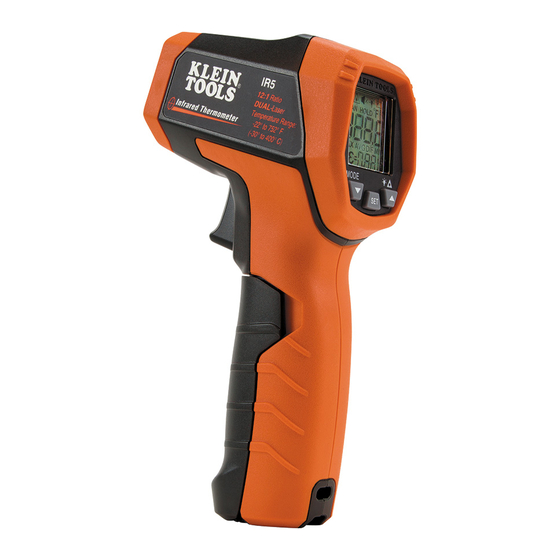Table of Contents
Advertisement
Available languages
Available languages
Quick Links
Advertisement
Table of Contents

Summary of Contents for Klein Tools IR5
- Page 1 ENGLISH INSTRUCTION MANUAL Dual-laser Infrared Thermometer • DUAL-LASER TARGETING • 12:1 DISTANCE- TO-SPOT RATIO • AUTO-SCAN • MAX/MIN/AVG/DIFF • HIGH/LOW ALARM • BACKLIT DISPLAY • AUTO POWER-OFF • ADJUSTABLE EMISSIVITY -22° – 752°F -30° – 400°C ESPAÑOL pg. 11 FRANÇAIS pg.
-
Page 2: General Specifications
ENGLISH GENERAL SPECIFICATIONS WARNINGS Klein Tools IR5 is a professional dual-laser targeting infrared To ensure safe operation and service of the meter, follow these instructions. thermometer. It offers a wide measurement range, a tight distance- Failure to observe these warnings can result in severe injury or death. -
Page 3: Feature Details
ENGLISH FEATURE DETAILS SYMBOLS ON LCD Indicates active measurement Targeting lasers active Backlight active HOLD Data Hold Low battery indicator °F °C Indicates active temperature scale Indicates measurement mode Emissivity High / Low temperature limit indicators Enable / disable audible temperature limit alarms Front NOTE: There are no user-serviceable parts inside meter. -
Page 4: Temperature Measurement
TEMPERATURE MEASUREMENT BACKLIGHT The backlight may be toggled on/off by short presses of control To measure temperature with the IR5, aim the meter at the object to button . When on, the backlight icon will be visible on the display. -
Page 5: Maintenance
3. Replace 9V battery and return battery compartment cover, Emissivity on the IR5 may be adjusted from 0.10 to 1.00 to enable ensuring that it locks into place. accurate measurement of the temperature of most types of materials. - Page 6 ENGLISH ESPAÑOL NOTES MANUAL DE INSTRUCCIONES Termómetro infrarrojo de doble láser • DOBLE LÁSER DE ENFOQUE DEL OBJETIVO • RELACIÓN DISTANCIA A OBJETIVO 12:1 • AUTOESCANEO • MÁX./MÍN./PROM./DIF. • ALARMA ALTA/BAJA • PANTALLA RETROILUMINADA • APAGADO AUTOMÁTICO • AJUSTE DE EMISIVIDAD -22°...
-
Page 7: Especificaciones Generales
ESPAÑOL ESPECIFICACIONES GENERALES ADVERTENCIAS El IR5 de Klein Tools es un termómetro infrarrojo profesional de doble láser de Para garantizar un funcionamiento y servicio seguros del enfoque del objetivo. Posee un amplio rango de medición, una relación distancia instrumento, siga estas instrucciones. El incumplimiento de estas a objetivo ajustada, doble láser de enfoque del objetivo y varios modos de cálculo... - Page 8 ESPAÑOL DETALLES DE LAS CARACTERÍSTICAS SÍMBOLOS DE LA PANTALLA LCD Indica que la medición está activada. Indica que los láseres de enfoque del objetivo están activados. Indica que la retroiluminación está encendida. HOLD Retención de datos Indicador de batería baja. °F °C Indica qué...
-
Page 9: Selección De Modos
RETROILUMINACIÓN MEDICIÓN DE TEMPERATURA La retroiluminación se puede encender y apagar presionando Para medir temperatura con el IR5, apunte el instrumento hacia brevemente el botón de control . Cuando está encendida, el el objeto que desea medir y mantenga presionado el gatillo icono de retroiluminación se visualiza en la pantalla. -
Page 10: Mantenimiento
3. Instale otra batería de 9 V, vuelva a colocar la tapa del compartimento de la batería y compruebe que quede bloqueada en su posición. La emisividad del IR5 se puede ajustar entre 0,10 y 1,00 para lograr mediciones precisas en la mayoría de los tipos de materiales. En LIMPIEZA términos generales, las superficies brillantes y lustrosas, como el... -
Page 11: Manuel D'utilisation
ESPAÑOL FRANÇAIS NOTAS MANUEL D’UTILISATION Thermomètre à infrarouge à double laser • ACQUISITION DE LA CIBLE À DOUBLE LASER • RAPPORT DISTANCE-CIBLE DE 12:1 • BALAYAGE AUTOMATIQUE • MAX/MIN/AVG (MOY)/DIFF • ALARME ÉLEVÉE/BASSE • AFFICHAGE RÉTROÉCLAIRÉ • ARRÊT AUTOMATIQUE • ÉMISSIVITÉ AJUSTABLE -22°... -
Page 12: Caractéristiques Générales
AVERTISSEMENTS Pour garantir une utilisation et un entretien du multimètre L’IR5 de Klein Tools est un multimètre à infrarouge à acquisition de la cible à double laser de sécuritaires, suivez ces instructions. Le non-respect de ces qualité professionnelle. Il offre une vaste plage de mesure, un rapport distance-cible étroit, avertissements peut entraîner des blessures graves, voire la mort. -
Page 13: Caractéristiques Détaillées
FRANÇAIS CARACTÉRISTIQUES DÉTAILLÉES SYMBOLES À L’AFFICHAGE ACL Indicateur de la mesure en cours Lasers d’acquisition de la cible activés Rétroéclairage activé HOLD Maintien des données Indicateur de pile faible °F °C Indicateur de l’échelle de température active Indicateur du mode de mesure Émissivité... -
Page 14: Instructions D'utilisation
INSTRUCTIONS D’UTILISATION MESURE DE LA TEMPÉRATURE RÉTROÉCLAIRAGE Le rétroéclairage peut être activé et désactivé en appuyant Pour prendre des mesures avec l’IR5, visez l’objet à mesurer brièvement sur le bouton de contrôle . Lorsqu’il est activé, avec l’appareil, actionnez la gâchette et maintenez-la enfoncée... -
Page 15: Entretien
3. Insérez une nouvelle pile de 9 V et replacez le couvercle du compartiment à pile en vous assurant qu’il s’enclenche L’émissivité du IR5 peut être ajustée de 0,10 à 1,00 pour assurer correctement. l’exactitude des mesures de température sur la majorité des types de matériaux. - Page 16 FRANÇAIS REMARQUES REMARQUES...
- Page 17 KLEIN TOOLS, INC. 450 Bond Street Lincolnshire, IL 60069 1-800-553-4676 customerservice@kleintools.com www.kleintools.com 1390159 Rev. 11/21 H...












Need help?
Do you have a question about the IR5 and is the answer not in the manual?
Questions and answers